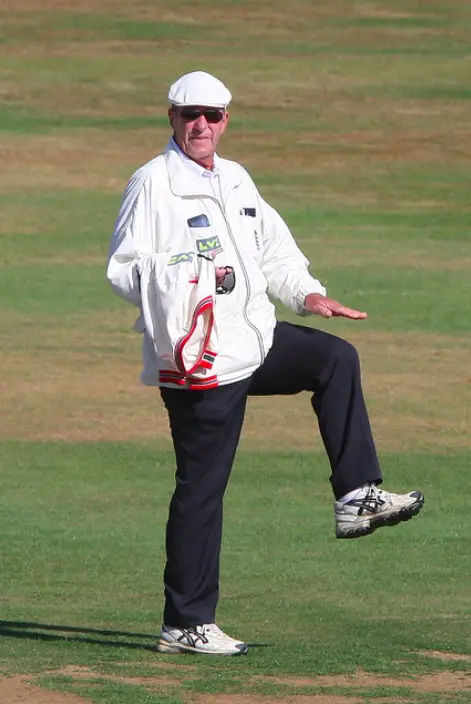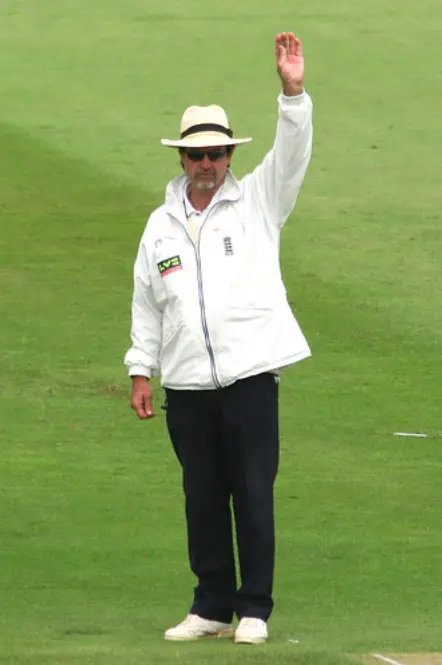When it comes to the game of Cricket, there are several terms that are used occasionally but it is important to be aware of them! Byes & Leg Byes in Cricket are one such example. Byes & Leg Byes are important pieces of the game, but it is easy for a beginner to get confused between the two or not know it at all!
In Cricket, a Bye is given when a batsman misses the ball yet he is able to score runs because the wicketkeeper fails to collect the ball. Whereas, a Leg Bye is given when the ball misses the bat but hits the batman’s body or equipment and runs are scored. Both byes and leg byes are considered as extras.
Byes and Leg Byes do not count are runs for the batsman, and they are considered as extra runs. There is a lot more to know about Byes & Leg Byes in Cricket. So, let’s get to the bottom of it!
Leg Byes in Cricket
We shall first cover the two topics of Byes and Leg Byes separately in the this article. First, we shall talk about Leg Byes.
What is a Leg Bye in Cricket?
As explained above, a leg bye is given by the umpire when the ball misses the bat, but hits the batsman’s body or any other part of the equipment and the runs are scored.
The video below is a good example of a Leg Bye –
As per the laws of cricket, the umpire has to consider if the striker has genuinely tried to play the ball or not before declaring it a Leg Bye. This decision is solely in the umpire’s hand.
The Leg Byes are granted if the umpire deems that the batsman has –
- Either attempted to play the ball using the bat but missed,
- or tried defending himself from being hit by the ball by taking an evasive action
If the umpire is not convinced that the striking batsman has performed any of the above two actions, he will still permit the batsmen to take a run – Only to give the fielding team a chance to run-out the batsman. After that, the umpire will call it a Dead ball.
What is the Umpire’s Signal for a Leg Bye?

It is important to recognize when the umpire has signaled a Leg Bye. For this, we need to the umpire’s signal for a leg bye.
The umpire’s signal for a leg bye is quite simple. The umpire will simply raise his one leg and tap on that leg to signal that the ball has hit the leg of the batsman.
This can be showcased by the image shared where the umpire has signaled a leg bye during a cricket match.
It is important to note that if the ball hits the bat of the batsman and then hits the pads or any other part of the body, it is not considered a leg bye and the runs are in fact awarded to the batsman.
Do Leg Byes Count against the Bowler?
Leg Byes are not counted against the bowler. This means that the runs scored as leg byes won’t reflect in the bowler’s statistics for the match.
This is because, unlike the no-ball and the wides, the delivery is not erroneous. Thus, a bowler is not penalized for any leg byes that occur and it is not counted against the bowler.
It is also for the reason that the leg byes are not added to the batsman’s score either. Leg Byes are in fact considered as Fielding Extras since the occurrence of Leg Byes depends on the after-delivery circumstances such as the wicket-keeper failing to catch the ball. Therefore, they are added to the team’s total score.
How Many Runs can be Scored on a Leg Bye?
This is an interesting question. The possibility of scoring runs on a leg bye is quite limited, but, sometimes unusual scenarios can exist leading to unusual outcomes.
Did You Know?
If the ball doesn’t hit the bat of the batsman, even if the ball goes directly over the boundary rope (which is usually given as a six), will only be considered as a boundary!
In most matches, you will see that the ball hits the batsman and they are able to get 1 or 2 runs. Sometimes, if a fast bowler is bowling, the ball may also run away for a four after hitting the body of the batsman.
However, in an unusual scenario, the batting team was once able to score 7 runs on a leg bye on 1 ball! Let’s watch the video below!
Add to the scenario that unfolded in the above video, if the bowler had bowled a no-ball by overstepping, the theoretical possibility of scoring maximum runs of a leg bye would be 8 runs in such a scenario.
However, such an event has never taken place in International Cricket thus far.
Can a Batsman be Given OUT on a Leg Bye?
A batsman can be given OUT as Run Out even on a Leg Bye. If the ball hits the batsman’s body and the batsman leaves the crease to score a run but gets run out before reaching the crease, he can be given OUT as Run Out.
If the batsman are have completed at least 1 run and get run out in the process of getting the 2nd or the 3rd run, then the total runs that have been completed by the two batsmen will get added to the team’s total even though the batsman will be given out.
If a batsman is given OUT LBW even if he has completed a run, no run will be considered. Thus, this will not be considered as a Leg Bye, but rather a dismissal of a batsman by LBW.
Byes in Cricket
Now that we have explained about Leg Byes in detail, let’s look at what are considered as Byes in cricket and how are they different from Leg Byes.
What is a Bye in Cricket?
Bye in cricket is the term given to the runs scored by the batsman when the ball is delivered by the bowler but it completely misses his bat, body, or any other part of his equipment however the runs are scored.
Imagine this scenario – The bowler has delivered the ball. Batsman tried to hit, but couldn’t. Without touching him or his bat, the ball has traveled past the batsman. The ball didn’t touch the stumps. The wicket-keeper couldn’t catch the ball either. Now, the ball is headed towards the boundary. A fielder stops it. Meanwhile, the batsmen have taken a run.
This is a perfect example of how Byes are scored in Cricket.
Byes in cricket are conceded usually if the wicket-keeper fails to collect the ball or if the bowler has bowled so far away from the stumps that neither the batsman nor the wicket-keeper has any chance to connect with it.
What is the Umpire’s Signal for a Bye

Each event has a specific signal in cricket. So is the case for runs scored through a Bye in cricket.
The signal given by the umpire for the runs scored from a Bye is by raising one hand over his head (as shown in the image).
The umpire can raise any of the two arms to signal a bye.
It is easy to confuse the signal with a six (especially for beginners). The difference is that for a six, the umpire has to raise both his arms, however, for a bye the umpire only has to raise one arm.
If a bowler bowls a no-ball or a wide ball and the runs are scored, the umpire shall first signal the no-ball or a wide ball first, and then show the signal for a bye.
Do the Runs from Bye Count for the Batsman?
Runs scored on a Bye are added to the team’s total score and not batsman’s. In fact, the Byes are scored against the wicket-keeper as he is considered accountable for missing the ball.
For a Bye to occur, it is only the wicket-keeper who has missed catching the ball. Thus, it is considered against the fielding team not considered for the batsman.
How Many Runs can be Scored off a Bye?
In theory, the maximum runs that can be scored off of a bye is 8 runs.
This could happen if the bowler manages to bowl a wide ball or a no-ball, the ball goes towards the third man (without hitting the bat or the batsman, and misses the wicket-keeper as well). The fielder collects the ball and throws it towards the wicket-keeper. Meanwhile, the batsmen have scored 3 runs. But, the throw is wayward and the ball runs towards the boundary as 4 overthrows.
In such a scenario, 1 run will be given as wide or a no-ball, 3 runs given to the batsman for running between the wickets and 4 overthrow runs will also be given by the umpire.
All the 8 runs conceded will be added to the extras in the scoreboard and will not be given to the batsman.
Can a Batsman be given OUT on a Bye?
Yes. The batsman can be given OUT on the Bye. The batsman can be given out either as Run Out or as Out Obstructing the Field.
[If you need help understanding the different ways in which a batsman can be given out, we wrote a post describing all the 10 different ways in detail. Give it a read – https://cricketmastery.com/types-of-dismissals-in-cricket/]
In the death overs, when scoring a run is crucial, batsman risks his wicket hoping that the wicket-keeper would miss the ball. In such cases, the non-striker often gets run-out.
Related Questions
Here are some additional queries that you may have regarding Byes & Leg Byes in Cricket –
What is the Maximum Runs Conceded by a Team in a Cricket Match through Extras?
When it comes to extras, the world of cricket has seen some mind-boggling records. Here are some of them –
Maximum Runs Conceded in an ODI Match through Extras –
In a ODI match between West Indies and Pakistan in 1989, Pakistan conceded 59 extras. Interestingly, Pakistan repeated history by conceding exactly 59 extras to Scotland in the 1999 World Cup. This is the record for the highest extras conceded by a team in an ODI.
Maximum Runs Conceded in a Test Match through Extras –
When it comes to Test Matches, India holds the record for conceding the most extras in a match. In 2007, during a Test Match between India and Pakistan, India conceded 76 extras (35 byes, 26 leg byes, 0 wides, and 15 no balls).
Which Bowler has conceded the Maximum Extras in an Over?
In the international cricket match between Pakistan and Bangladesh, Mohammed Sami, a bowler from Pakistan team, delivered a 17-ball over. He gave away 22 runs by delivering seven wides and four no-balls.
In a domestic county cricket match, Wellington against Canterbury, New Zealand’s Bert Vance delivered an over that had 22 balls conceding 77 runs in the over to Canterbury.

